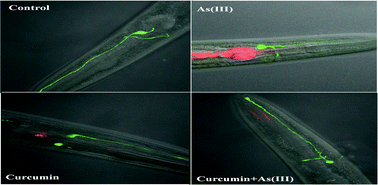Arsenite induces neurotoxic effects on AFD neurons via oxidative stress in Caenorhabditis elegans†
Abstract
Arsenic permeates our environment. As a result, humans are continually exposed to it. This study investigates the possible roles of oxidative stress in arsenite (As(III))-induced neurotoxicity in Caenorhabditis elegans. Exposure to As(III), at the concentrations examined, caused a decrease in locomotor behaviors (frequencies of body bends, head thrashes, and reversals) of C. elegans. In addition, As(III) exposure (100 μM) decreased thermotactic behaviors, and induced severe deficits in the structural properties of AFD sensory neurons. Exposure to As(III) (100 μM) also caused an elevated production of intracellular reactive oxygen species (ROS) in wild-type C. elegans. Pretreatment with the antioxidant curcumin ameliorated the decrease in locomotor and thermotactic behavior, the formation of deficits in the structural properties of AFD sensory neurons, and intracellular ROS in As(III)-exposed nematodes. Our study suggests that oxidative stress plays a crucial role in the As(III)-induced neurotoxic effects on locomotor behavior and the structures and function of AFD sensory neurons in As(III)-exposed nematodes.


 Please wait while we load your content...
Please wait while we load your content...